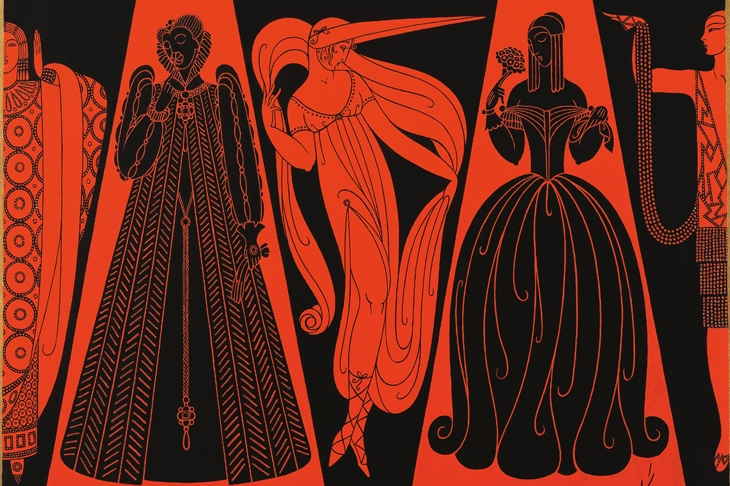Erté was destined for the imperial navy. Failing that, the army. His father and uncle had been navy men. There were painters and sculptors on his mother’s side, but they were thought very frivolous. Romain de Tirtoff (‘Erté’ came from the French pronunciation of his initials) was born in 1892 at the St Petersburg Naval School where his father Pyotr was inspector. When he was a little boy, his aunt bought him a set of wooden soldiers. Instinctively, he hated war, violence and, above all, uniforms. He burst into tears and threw the box out of the window.
What he liked best was to play with his mother’s old perfume bottles, which he dressed in scraps of lace to make ballerinas. That is what Erté did for the rest of his long and productive life until his death in 1990, aged 97. He created wonderful, wild, impossible costumes for fantasy figures. His heroines were femmes fatales, black widows, courtesans and vengeful goddesses. He designed for Cleopatra, Nefertiti, Scheherazade, Salome, Messalina, Helen of Troy, Hera, Diana, Circe; for sphinxes and sleeping beauties. He invented a pantheon of mythological and symbolic figures, personifications of the letters of the alphabet, the seasons, star signs, numbers, jewels and the seven deadly sins. Sloth reclines on a pile of tasselled cushions and kicks off her slippers. Erté called one of his series simply ‘The Diva Suite’.
He was apprenticed to the great couturier Paul Poiret and contributed more than 2,500 drawings to Harper’s Bazaar over 20 years — 240 of them made the cover. He dreamt up costumes for the stage, the opera, the ballet, for Broadway and Hollywood, the West End and the Folies Bergère. He styled shop windows and designed playing cards. The Ace of Clubs wears a black leotard and balloon sleeves embroidered with pearls.








Comments
Join the debate for just £1 a month
Be part of the conversation with other Spectator readers by getting your first three months for £3.
UNLOCK ACCESS Just £1 a monthAlready a subscriber? Log in